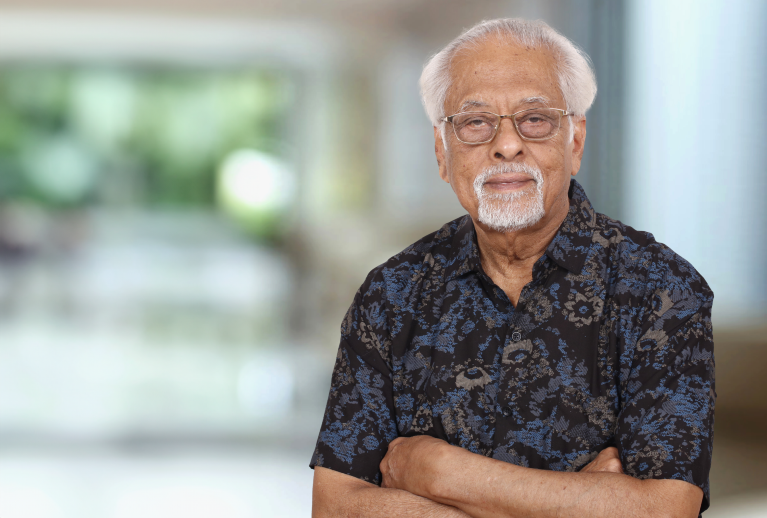
Partha Ghose. Credit: Partha Ghose
Nature India: What inspired you to embark on a career in particle physics?
Partha Ghose: In 1961, I went to Imperial College London wanting to decipher what lies at the deepest core of matter. This was when physicists had already begun smashing atoms in colliders, churning out new transient particles to unveil the secrets of matter.
I was lucky to learn advanced physics from stalwarts in particle physics like Abdus Salam, P. T. Matthews and T. W. B. Kibble. In 1963, an opportunity to work briefly at CERN further spurred my interest in particle physics.
NI: How did you meet S. N. Bose?
PG: It was in mid-1963 that I met Bose, quite by chance. The famous Bengali pote Bishnu Dey, a relative of ours and Bose’s close friend, took me to meet Bose. They were immersed in discussion, and Bose suddenly turned to me and asked, ''Would you like to work with me?''. It was an offer I couldn’t refuse. He arranged everything very quickly and within days I joined his research group at the Saha Institute of Nuclear Physics in Calcutta as a junior scientist. I worked on particle physics, mainly on broken SU(3) symmetry which was in vogue at the time.
NI: How did Bose start interacting with Einstein and how was their relationship?
PG: Occasionally, Bose would reminisce about his interactions with Einstein. One day when I went to meet him at his residence, he started talking about the historic paper he sent to Einstein on 4 June 1924 along with a letter.
Bose told me that his deduction of the phase space factor in Planck’s law resulted in a factor of 4π instead of 8π. He went on to propose that the missing factor of 2 was due to the photon spin which could take only two values. In his letter back to Bose, “the old man” [Einstein] had crossed this portion out and said it was not necessary to talk about spin since the factor of 2 comes from the two states of polarisation of light.”
Bose said to me, ”I can understand a spinning particle, but what is the meaning of the polarization of a particle?” I asked him, "Sir, when the photon spin was eventually discovered, why didn’t you tell Einstein that you had already worked it out in 1924?” “How does it matter who discovered it,” he quipped. “It was eventually discovered, wasn’t it?”
In a second paper, which also Einstein translated into German and got published in Zeitschrift fur Physik, Bose proposed a probability law for interactions between matter and radiation. According to Einstein, it was inappropriate. He added a comment to the paper giving some reasons for his disagreement with Bose.
The first paper with Einstein’s strong endorsement made Bose famous. He moved to Paris on a two-year sabbatical from Dhaka University, worked in Maurice de Broglie’s and Marie Curie’s labs and arrived in Berlin in 1925 to finally meet Einstein. They discussed several issues including Bose’s new hypothesis of probabilistic interactions, but Einstein stuck to his point.
Despite their differences, Bose regarded Einstein as his master in physics. On 18 April 1955, Einstein died. The news shocked him into silence. He was writing a paper and was looking forward to discussing it with Einstein at a forthcoming conference in Switzerland to celebrate fifty years of Special Relativity. Bose tore that paper into shreds.
NI: Many say that S. N. Bose missed out on a Nobel Prize for physics.
PG: He deserved the prize for his seminal contribution to quantum theory. It led to the classification of particles into bosons and fermions and the prediction and discovery of Bose-Einstein condensates. Besides, his theories helped us understand superconductivity and superfluidity. Bose’s theories and insights shaped the works of many physicists. Some went on to win Nobel Prizes. But Bose, despite being recommended several times, was never considered for the prize.
NI: Apart from physics, you learned music, and played first-class cricket. Do you think science helps enrich music?
PG: Science can help explain music. The best example of this in India is Sir C. V. Raman who had a keen ear for Indian classical music. He could detect five harmonics in the 'mridangam' and the 'tabla' sounds. He did some experiments with Indian drums and circular membranes with central loads. He sprinkled white powder on them to see the patterns of vibrations formed as he kept changing the loads and the manner of striking. This led to a new understanding of the generation of harmonics in stretched membranes. His research in musical instruments earned him the Fellowship of the Royal Society of London even before he got the Nobel Prize for his work on light scattering.
NI: S. N. Bose advocated popularizing science in Bengali. Is it easier to communicate science through one’s mother tongue?
PG: Science is based on logic and requires precise language for its expression and understanding. Non-native speakers find it difficult to grasp the nuances of scientific terms in English. They often acquire wrong notions when they read science in English.
The language in which one dreams is one's mother tongue. Science can therefore take root and flourish in a country only when its citizens start dreaming about science in their mother tongue.
NI: What is your advice for young Indian students who want to pursue a career in physics?
PG: I will quote Bose’s last advice to me. ''Don't jump onto foreign bandwagons. Try to understand things in your way and say something new.''
Bose read the works of all leading quantum theorists of his time, including Einstein, with a critical mind, identified their shortcomings and went on to propose revolutionary new statistics. These days I see an undue rush to publish papers in reputed foreign journals, increase citations, and get quick recognition and promotion. This leads to derivative science.
